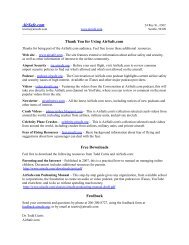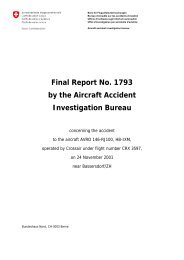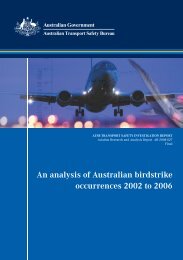AAIB Investigation Updates (PDF) - Airline Safety and Security ...
AAIB Investigation Updates (PDF) - Airline Safety and Security ...
AAIB Investigation Updates (PDF) - Airline Safety and Security ...
You also want an ePaper? Increase the reach of your titles
YUMPU automatically turns print PDFs into web optimized ePapers that Google loves.
<strong>AAIB</strong> Interim Report G-YMMM EW/C2008/01/01<br />
Just over two hours from touchdown the TAT started to<br />
rise, in response to the increasing SAT; this was followed<br />
by an associated rise in fuel temperature. About twenty<br />
minutes later, the aircraft made its second <strong>and</strong> final step<br />
climb from FL380 to FL400. This was also completed<br />
using the VS mode of the autopilot, but with a slightly<br />
higher vertical speed of 600 fpm set. During this climb<br />
the peak fuel flow was 8,896 pph for the left engine <strong>and</strong><br />
8,704 pph for the right engine.<br />
At 1202 hrs the aircraft commenced its descent before<br />
levelling at FL110, to enter the hold at Lambourne;<br />
it remained in the hold for about five minutes, during<br />
which it descended to FL90. In the first few minutes<br />
of the descent the fuel flows on both engines reduced to<br />
970 pph, with two peaks to a maximum of 4,900 pph,<br />
until the aircraft entered the hold, when the fuel flows<br />
increased to 5,500 pph. The aircraft was then radar<br />
vectored for an ILS approach to Runway 27L. The<br />
aircraft subsequently stabilised on the ILS with the<br />
autopilot <strong>and</strong> autothrottle systems engaged <strong>and</strong> at a<br />
height of about 1,200 ft, the aircraft was configured for<br />
l<strong>and</strong>ing <strong>and</strong> 30º of flap was selected. By this time the<br />
fuel temperature had risen to ‐22°C (‐8°F).<br />
As the flaps reached the 30º position the airspeed had<br />
reduced to the target approach speed of 135 kt <strong>and</strong> the<br />
autothrottle comm<strong>and</strong>ed additional thrust to stabilise the<br />
airspeed (Figure 2 Point A). In response to variations in<br />
the wind velocity <strong>and</strong> associated airspeed changes, there<br />
followed a series of four, almost cyclic, thrust comm<strong>and</strong>s<br />
by the autothrottle (Figure 2 Points B). It was during the<br />
fourth acceleration, <strong>and</strong> as additional thrust was being<br />
comm<strong>and</strong>ed, that the right engine, followed some seven<br />
seconds later by the left engine, experienced a reduction<br />
in fuel flow (Figure 2 Points C). The right engine fuel<br />
flow reduction occurred at a height of about 720 ft <strong>and</strong><br />
the left engine at about 620 ft.<br />
Of the four thrust comm<strong>and</strong>s it was the second that<br />
resulted in the highest delivery of fuel flow, reaching a<br />
peak of 12,288 pph for the left engine <strong>and</strong> 12,032 pph<br />
for the right (Figure 2 Point D). These peaks occurred<br />
about 26 seconds prior to the reduction in fuel flow to<br />
the right engine. Peak fuel flows during the first <strong>and</strong><br />
third thrust comm<strong>and</strong>s were lower, at about 9,500 pph<br />
<strong>and</strong> 9,000 pph respectively.<br />
During the fourth thrust increase, the right engine<br />
fuel flow had increased to 8,300 pph before gradually<br />
reducing. The recorded EPR then started to diverge from<br />
the comm<strong>and</strong>ed EPR <strong>and</strong> the right engine FMV was then<br />
fully opened (Figure 2 Point E). Some seven seconds<br />
later, the left engine fuel flow, which had increased to<br />
11,056 pph, also started to reduce <strong>and</strong> the left engine<br />
FMV was also moved to its fully open position (Figure<br />
2 Point F). Following the reduction in fuel flow, the<br />
left engine fuel flow stabilised at about 5,000 pph <strong>and</strong><br />
the right at about 6,000 pph. Both engines continued to<br />
produce thrust above flight idle. The autothrottle <strong>and</strong> the<br />
flight crew comm<strong>and</strong>ed additional thrust, with both thrust<br />
levers ultimately being placed fully forward, but there<br />
was no increased thrust available from either engine.<br />
The actual fuel flows continued to remain significantly<br />
below that being comm<strong>and</strong>ed.<br />
At 240 ft the aircraft comm<strong>and</strong>er selected flap 25 in an<br />
attempt to reduce the drag. As the autopilot attempted to<br />
maintain the aircraft on the ILS glideslope the airspeed<br />
reduced <strong>and</strong> by 200 ft had reached 108 kt. The stick<br />
shaker activated at approximately 170 ft, <strong>and</strong> shortly<br />
afterwards the First Officer made a nose down pitch<br />
control input which reduced the aircraft pitch attitude<br />
<strong>and</strong> caused the auto pilot to disconnect. The aircraft’s<br />
initial impact was at a descent rate of about 1,400 fpm<br />
<strong>and</strong> a peak normal load of about 2.9g. The aircraft then<br />
bounced, before commencing a ground slide, during<br />
© Crown copyright 2008<br />
4











